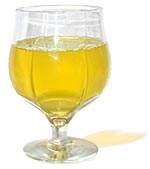|
Kombucha is a living health
drink made by fermenting tea and sugar with the kombucha culture. The
result can taste like something between sparkling apple cider and champagne,
depending on what kind of tea you use. It's not what you'd imagine fermented
tea to taste like.
 The
origins of Kombucha have become lost in the mists of time. It is thought
to have originated in the Far East, probably China, and has been consumed
there for at least two thousand years. The first recorded
use of kombucha
comes from China in 221 BC during the Tsin Dynasty. It was known as "The
Tea of Immortality". The
origins of Kombucha have become lost in the mists of time. It is thought
to have originated in the Far East, probably China, and has been consumed
there for at least two thousand years. The first recorded
use of kombucha
comes from China in 221 BC during the Tsin Dynasty. It was known as "The
Tea of Immortality".
It has
been used
in Eastern Europe, Russia and Japan for several centuries. It's from
Japan in 415 AD that the name kombucha is said to have come. A Korean
physician called Kombu or Kambu treated the Emperor Inyko with the
tea and it took his name, "Kombu" and "cha" meaning tea. Russia has a
long
tradition of using a healing drink called "Tea Kvass" made from a "Japanese
Mushroom".
From Russia it spread to Prussia, Poland, Germany and Denmark but it
seems to have died out during World War Two. After the war Dr Rudolph
Skelnar created renewed interest in kombucha in Germany when he used
it in his practice to treat cancer patients, metabolic disorders, high
blood
pressure and diabetes.
The Kombucha Culture
The Kombucha culture looks like a beige or white rubbery pancake.
It's often called a 'scoby' which stands for ' symbiotic culture of
bacteria and yeasts.The culture is placed in sweetened black or
green tea
and turns a bowl full of sweet tea into a bowl full of vitamins,
minerals, enzymes and health-giving organic acids.
 As the Kombucha
culture
digests
the sugar it produces a range of organic acids like glucuronic
acid, gluconic acid, lactic acid, acetic acid, butyric acid,
malic acid
and usnic acid; vitamins, particularly B vitamins and vitamin
C; as well
as amino acids, enzymes. And of course there are all the benefits
of the probiotic microorganisms themselves. The Kombucha culture
is a
biochemical powerhouse in your kitchen. As the Kombucha
culture
digests
the sugar it produces a range of organic acids like glucuronic
acid, gluconic acid, lactic acid, acetic acid, butyric acid,
malic acid
and usnic acid; vitamins, particularly B vitamins and vitamin
C; as well
as amino acids, enzymes. And of course there are all the benefits
of the probiotic microorganisms themselves. The Kombucha culture
is a
biochemical powerhouse in your kitchen.
You might wonder if fermenting tea with yeasts would produce an alcoholic
beverage. It's a good question. The yeasts do produce alcohol but the
bacteria in the culture turn the alcohol to organic acids. Only minute
quantities of alcohol, typically 1% by volume remains in the kombucha
brew.
With every brew you make the kombucha forms a new layer or scoby on
the surface of the liquid. These can be left to thicken the scoby or
can be divided, giving you spare cultures that you can store in some
sweet tea in the fridge in case something should happen to your active
culture. Or you might want to pass on spare Kombucha cultures to friends
or use
a new scoby to start another batch of kombucha.
Kombucha and Health
Many health claims are made for kombucha but there is less research
on the benefits of kombucha than there is on fermented milk products.
It has certainly been shown to have similar antibiotic, antiviral and
anti fungal properties in lab tests. In rats it’s been shown to
protect against stress and improve liver function. There is a lot of
experiential evidence from people who have been using kombucha over many
years. Many of the benefits reported include improvements in energy levels,
metabolic disorders, allergies, cancer, digestive problems, candidiasis,
hypertension, HIV, chronic fatigue and arthritis. It ‘s also used
externally for skin problems and as a hair wash among other things.
The Organic Acids
Glucuronic acid
The body's most important detoxifier. When toxins enter the liver this
acid binds them to it and flushes them out through the kidneys.
Once bound by glucuronic acid toxins cannot escape. A product of the
oxidation
process of glucose, glucuronic acid is one of the more significant
constituents of Kombucha. As a detoxifying agent it's one of the
few agents that can cope with pollution from the products of the
petroleum industry, including all the plastics, herbicides, pesticides
and
resins.
It kidnaps the phenols in the liver, which are then eliminated
easily by the kidneys. Kombucha can be very helpful for allergy sufferers.
Another by-product of glucuronic acid are the glucosamines, the
structures
associated with cartilage, collagen and the fluids which lubricate
the joints. It is this function that makes Kombucha so effective
against arthritis.
Lactic Acid
Essential for the digestive system. Assist blood circulation, helps prevent
bowel decay and constipation. Aids in balancing acids and alkaline
in the body and believed to help in the prevention of cancer by helping
to regulate blood pH levels.
Acetic Acid
A powerful preservative and it inhibits harmful bacteria.
Usnic Acid
A natural antibiotic that can be effective against many viruses.
Oxalic Acid
An effective preservative and encourages the intercellular production
of energy.
Malic acid
Helps detoxify the liver.
Gluconic Acid
Produced by the bacteria, it can break down to caprylic
acid is of great benefit to sufferers of candidiasis
and other
yeast infections
such as thrush.
Butyric acid
Produced by the yeast, protects human cellular membranes
and combined with Gluconic acid strengthens the walls
of the gut
to combat yeast
infections like candida.
Types of Tea for Kombucha
 Kombucha requires tea for its fermentation (Camellia Sinensis).
That's real tea not herbal tea. It can be also be sensitive to strong
aromatic oils. A tea like Earl Grey that contains Bergamot oil, can sometimes
kill or badly affect the culture. There are several different kinds of
tea that give different results from lighter tastes to stronger more
cider like tastes. Kombucha requires tea for its fermentation (Camellia Sinensis).
That's real tea not herbal tea. It can be also be sensitive to strong
aromatic oils. A tea like Earl Grey that contains Bergamot oil, can sometimes
kill or badly affect the culture. There are several different kinds of
tea that give different results from lighter tastes to stronger more
cider like tastes.
Black Tea
Black tea is made from leaves that have been fully fermented.
The leaf is spread out and left to wilt naturally, before being fired,
producing a deep, rich flavour and an amber brew.
Oolong Tea
Oolong tea is half way between green tea and black tea. It's gently
rolled after picking and allowed to partially ferment until the edges of
the leaves start to turn brown. Oolong combines the taste and colour of
black and green tea.
Green Tea
Green
tea is withered then steamed or heated to prevent oxidation and
then rolled and dried. It is characterized by a delicate
taste, light
green colour.
The Japanese tea Sencha makes an especially fine kombucha.
White Tea
White Tea is the rarest and most delicate of tea. Plucked forty-eight
hours or less between the time the first buds become fully mature and
the time they open. Unlike black and green teas, white tea isn't rolled
or steamed, but simply aired dried in the sun, this preserves more of
its antioxidant properties. White tea has about three times as many antioxidant
polyphenols as green. White tea represents the least processed form of
tea.
References
The
Ubiquitous Co-Enzyme UDPGlucuronic Acid Detoxifying Agent in Kombucha
Tea? By Norbert Hoffmann.
The History and Spread of Kombucha By James
Roche.
Kombucha Tea for Your Health and Healing.
The
Fascination of Kombucha by Günther W. Frank
|





